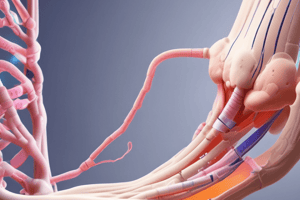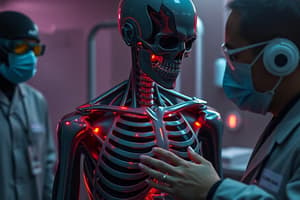Podcast
Questions and Answers
Which joint is assessed for asymmetry during the examination?
Which joint is assessed for asymmetry during the examination?
- Ankle joint
- Knee joint
- Sacroiliac joint
- Subtalar joint (correct)
Which muscles help to reduce the load on the lumbar spine?
Which muscles help to reduce the load on the lumbar spine?
- Abdominal muscles (correct)
- Gluteus medius and quadratus lumborum
- Thoracic muscles
- Trunk muscles
What is the end feel of the lumbar spine during the assessment of joint play movements?
What is the end feel of the lumbar spine during the assessment of joint play movements?
- Tissue stretch (correct)
- Bone-on-bone
- Fluid movement
- Muscle contraction
What is the purpose of the Dynamic Abdominal Endurance Test?
What is the purpose of the Dynamic Abdominal Endurance Test?
What is the grading for the isometric abdominal test?
What is the grading for the isometric abdominal test?
What position should the patient be in for the Dynamic Abdominal Endurance Test?
What position should the patient be in for the Dynamic Abdominal Endurance Test?
Which movement should the examiner perform after the patient has completed the basic movements?
Which movement should the examiner perform after the patient has completed the basic movements?
What is the maximum range of motion (ROM) in the lumbar spine for flexion (forward bending)?
What is the maximum range of motion (ROM) in the lumbar spine for flexion (forward bending)?
What may indicate hypomobility in the lumbar spine?
What may indicate hypomobility in the lumbar spine?
What is the Kirkaldy-Willis description of degenerative changes in the disc?
What is the Kirkaldy-Willis description of degenerative changes in the disc?
What is an instability jog?
What is an instability jog?
What should the examiner watch for when the patient bends one or both knees on forward flexion?
What should the examiner watch for when the patient bends one or both knees on forward flexion?
Which movement did McKenzie advocate repeating 10 times to see whether the symptoms increased or decreased?
Which movement did McKenzie advocate repeating 10 times to see whether the symptoms increased or decreased?
When should combined movements of the spine be included in the examination?
When should combined movements of the spine be included in the examination?
Which symptom would indicate facet involvement?
Which symptom would indicate facet involvement?
When should the quick test of the lower peripheral joints be performed?
When should the quick test of the lower peripheral joints be performed?
What does a positive Trendelenburg sign indicate?
What does a positive Trendelenburg sign indicate?
When does flexion in the spine take place from above downward?
When does flexion in the spine take place from above downward?
Which of the following is true about assessing the lumbar spine?
Which of the following is true about assessing the lumbar spine?
What should the examiner do when assessing a joint in the presence of symptoms originating in the lumbar spine?
What should the examiner do when assessing a joint in the presence of symptoms originating in the lumbar spine?
What type of movements should the examiner observe during the active movement assessment of the lumbar spine?
What type of movements should the examiner observe during the active movement assessment of the lumbar spine?
Which of the following is true about the most painful movements during the active movement assessment of the lumbar spine?
Which of the following is true about the most painful movements during the active movement assessment of the lumbar spine?
What is the range of forward flexion during the active movement assessment of the lumbar spine?
What is the range of forward flexion during the active movement assessment of the lumbar spine?
What should the examiner look for during the active movement assessment of the lumbar spine?
What should the examiner look for during the active movement assessment of the lumbar spine?
During straight leg raising, the movement occurs from below upward instead of from above downward.
During straight leg raising, the movement occurs from below upward instead of from above downward.
During active movements, the examiner should watch for a painful arc.
During active movements, the examiner should watch for a painful arc.
The pain seen in a lumbar painful arc tends to be neurologically based.
The pain seen in a lumbar painful arc tends to be neurologically based.
During the happy round maneuver, the patient attempts to arch or hunch the back.
During the happy round maneuver, the patient attempts to arch or hunch the back.
Extension (backward bending) is normally limited to 20° to 35° in the lumbar spine.
Extension (backward bending) is normally limited to 20° to 35° in the lumbar spine.
Side (lateral) flexion or side bending is approximately 15° to 20° in the lumbar spine.
Side (lateral) flexion or side bending is approximately 15° to 20° in the lumbar spine.
During straight leg raising, the movement occurs from below upward instead of from above downward.
During straight leg raising, the movement occurs from below upward instead of from above downward.
During the happy round maneuver, the patient attempts to arch or hunch the back.
During the happy round maneuver, the patient attempts to arch or hunch the back.
Extension (backward bending) is normally limited to 20° to 35° in the lumbar spine.
Extension (backward bending) is normally limited to 20° to 35° in the lumbar spine.
Side (lateral) flexion or side bending is approximately 15° to 20° in the lumbar spine.
Side (lateral) flexion or side bending is approximately 15° to 20° in the lumbar spine.
Rotation in the lumbar spine is normally 3° to 18° to the left or right.
Rotation in the lumbar spine is normally 3° to 18° to the left or right.
During the Modified Extension Test (MExT), if the patient is over 50 years old, symptoms are produced to the same side as the side flexion and symptoms radiate below the gluteal fold, the test is positive for lumbar spinal stenosis.
During the Modified Extension Test (MExT), if the patient is over 50 years old, symptoms are produced to the same side as the side flexion and symptoms radiate below the gluteal fold, the test is positive for lumbar spinal stenosis.
During the assessment of joint play movements, the examiner checks the end feel of the individual vertebrae in the lumbar spine. What is the end feel for flexion in the lumbar spine?
During the assessment of joint play movements, the examiner checks the end feel of the individual vertebrae in the lumbar spine. What is the end feel for flexion in the lumbar spine?
Which muscles help to reduce the load on the lumbar spine by approximately 30%?
Which muscles help to reduce the load on the lumbar spine by approximately 30%?
What is the grading for the isometric abdominal test if the patient can hold the end position with arms straight until scapulae clear table for 10-15 seconds?
What is the grading for the isometric abdominal test if the patient can hold the end position with arms straight until scapulae clear table for 10-15 seconds?
Which movement should the examiner perform after the patient has completed the basic movements during the examination of the lumbar spine?
Which movement should the examiner perform after the patient has completed the basic movements during the examination of the lumbar spine?
Which joint should the examiner assess for asymmetry during the examination of the lumbar spine?
Which joint should the examiner assess for asymmetry during the examination of the lumbar spine?
What is the purpose of the Dynamic Abdominal Endurance Test?
What is the purpose of the Dynamic Abdominal Endurance Test?
During the active movement assessment of the lumbar spine, which movement is normally the summation of the movements of the entire lumbar spine, along with hip movement?
During the active movement assessment of the lumbar spine, which movement is normally the summation of the movements of the entire lumbar spine, along with hip movement?
What should the examiner look for when the patient is performing the active movements of the lumbar spine?
What should the examiner look for when the patient is performing the active movements of the lumbar spine?
Which movement of the lumbar spine should be performed last during the active movement assessment?
Which movement of the lumbar spine should be performed last during the active movement assessment?
What is the range of motion (ROM) for side (lateral) flexion in the lumbar spine?
What is the range of motion (ROM) for side (lateral) flexion in the lumbar spine?
When should a screening or scanning examination accompany the assessment of a peripheral joint?
When should a screening or scanning examination accompany the assessment of a peripheral joint?
What should the examiner do after asking the patient to demonstrate the movements that produce or have produced pain?
What should the examiner do after asking the patient to demonstrate the movements that produce or have produced pain?
Which movement did McKenzie advocate repeating 10 times to see whether the symptoms increased or decreased?
Which movement did McKenzie advocate repeating 10 times to see whether the symptoms increased or decreased?
Which symptom would indicate facet involvement?
Which symptom would indicate facet involvement?
What is the purpose of the quick test of the lower peripheral joints?
What is the purpose of the quick test of the lower peripheral joints?
What is the purpose of the modified Trendelenburg test?
What is the purpose of the modified Trendelenburg test?
When should the examiner perform the flexion movements with the patient in the supine position?
When should the examiner perform the flexion movements with the patient in the supine position?
What is the purpose of assessing functional limb length during the observation stage?
What is the purpose of assessing functional limb length during the observation stage?
Which of the following is true about the range of motion (ROM) in the lumbar spine for flexion (forward bending)?
Which of the following is true about the range of motion (ROM) in the lumbar spine for flexion (forward bending)?
What is the purpose of applying passive overpressure during the active movement assessment of the lumbar spine?
What is the purpose of applying passive overpressure during the active movement assessment of the lumbar spine?
What is the significance of a sustained position increasing the symptoms in the lumbar spine?
What is the significance of a sustained position increasing the symptoms in the lumbar spine?
What is the effect of disc degeneration on intersegmental motion in the lumbar spine?
What is the effect of disc degeneration on intersegmental motion in the lumbar spine?
What does an instability jog during active movement of the lumbar spine indicate?
What does an instability jog during active movement of the lumbar spine indicate?
What should the examiner watch for when the patient bends one or both knees on forward flexion?
What should the examiner watch for when the patient bends one or both knees on forward flexion?
Flashcards are hidden until you start studying




